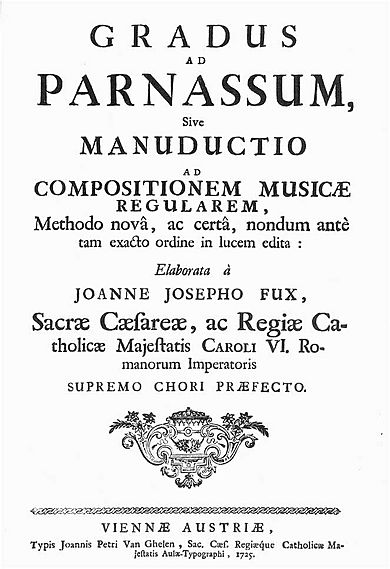Johann Joseph Fux facts for kids
Johann Joseph Fux (born around 1660 – died February 13, 1741) was an Austrian composer, music teacher, and expert in music theory from the late Baroque period. His most famous work isn't a piece of music, but a very important book about counterpoint called Gradus ad Parnassum. This book became the most influential guide for learning the style of Renaissance polyphony (music with many independent voice parts) used by Palestrina.
Contents
Life of Johann Joseph Fux
We don't know Fux's exact birthday. He was born into a farming family in Hirtenfeld, Styria, Austria. Not much is known about his early life, but he probably went to nearby Graz to learn music. In 1680, he joined the Jesuit Ferdinandeum University there, where his musical talent became clear.
From 1685 to 1688, he worked as an organist at St. Moritz in Ingolstadt. During this time, he likely traveled to Italy. We know this because his music from that period shows a strong influence from Italian composers like Corelli.
By the 1690s, Fux was in Vienna. He caught the attention of Emperor Leopold I with some of the masses he composed. The emperor was so impressed that he helped Fux with his career from then on. In 1698, Leopold hired him as a court composer. Fux traveled to Italy again, studying in Rome in 1700. It might have been there that he developed his great respect for Palestrina, which later became very important for how music was taught.
In 1715, Fux became the Hofkapellmeister. This was the top musician position for the Wiener Hofmusikkapelle, which was the court's official music group. He worked alongside Antonio Caldara and F.B. Conti.
Fux served Emperor Leopold I until the emperor's death. He then continued to work for two more Habsburg emperors: Joseph I and Charles VI. Both emperors kept him in important court positions. Fux was a famous composer during this time. He was known as the highest-ranking composer in the Holy Roman Empire.
However, his fame faded later in the 18th century as the Baroque music style went out of fashion. Even though his music didn't become popular again until recently, his amazing skill in counterpoint influenced many composers. This was all thanks to his book, Gradus ad Parnassum (published in 1725). For example, Haydn mostly taught himself counterpoint by reading Fux's book. Haydn also recommended it to a young Beethoven. Even Mozart owned a copy of the book and wrote notes in it.
Gradus ad Parnassum: Fux's Famous Book
Gradus ad Parnassum means "Steps to Mount Parnassus." Mount Parnassus was a place in ancient Greek stories where the Muses (goddesses of arts and sciences) lived. Fux wrote this book in Latin in 1725. It was later translated into German in 1742. Fux dedicated his important book to Emperor Charles VI.
The book has two main parts. The first part talks about Musica Speculativa. This is about understanding music in a very mathematical way, looking at how musical intervals relate to numbers. This idea goes back to ancient Greek thinkers. Fux explains that certain mathematical proportions create different kinds of half tones. He also mentions that some organists added extra keys to their instruments to play these different half tones. However, this was difficult, so they decided to divide every note into "two equal parts." This led to the idea of equal temperament, which is how pianos are tuned today.
The second part of the book is called Musica Pratica. This section teaches how to compose music, especially counterpoint and fugue. Counterpoint is about combining different melodies that sound good together. Fugue is a type of musical composition where a short melody is introduced by one part and then taken up by others. This part of the book is written as a conversation between a master (named Aloysius, representing Palestrina's ideas) and a student (named Josephus, representing Fux himself). Fux was a big admirer of Palestrina.
Fux explains his goal: "to invent a simple method by which a novice can progress, step by step, to attain mastery in this art." He also believes that learning music theory is useless without practicing it. So, his book focuses more on practice than just theory.
Gradus ad Parnassum is famous for introducing the term "species counterpoint." However, Fux wasn't the first to come up with this teaching method. In 1610, another composer named Girolamo Diruta published a book that also taught Renaissance polyphonic style in different "types." Fux's work was similar to Diruta's, but Fux probably didn't know about Diruta's book.
In species counterpoint, students learn to write counterpoint in different "species" or levels of difficulty. They master one level before moving to the next. The levels are:
- One note against one note.
- Two notes against one note.
- Four notes against one note.
- Ligature or suspensions (one note against one, but slightly offset).
- Florid counterpoint, where all the other levels are combined freely.
Once students master all these levels with two voices, they repeat the process with three voices, and then with four voices. Fux intended to add sections for more than four parts, but he stopped due to poor health.
Modern music education still uses ideas from Gradus ad Parnassum. Fux explained these ideas so clearly that many music textbooks still refer to his work. His book also shows the difference between the older, sacred music style and the newer, more modern style of the Baroque era.
Interestingly, the Latin version of Fux's Gradus ad Parnassum from 1725 was the only music theory book in J.S. Bach's personal library.
Fux's Musical Works
Besides writing Gradus ad Parnassum, Fux also composed many sacred (religious) and secular (non-religious) musical pieces. His compositions were listed and organized by Ludwig Ritter von Köchel, who also cataloged Mozart's works.
Sacred Compositions
Fux's sacred works include:
- Many masses (like Missa canonica). A mass is a musical setting of the church service.
- Requiems, which are masses for the dead.
- Oratorios (like Santa Dimpna). An oratorio is a large musical work for voices and orchestra, usually based on a religious story.
- Litanies, Vespers settings, motets, and other church music.
Some of Fux's masses used a technique called canon. This is a very strict form of imitative counterpoint, where a melody is repeated exactly by different voices. This was a sign of the stile antico (old style) of music.
Even though Fux is often linked to the stile antico because of his book, he could also compose in the stile moderno (modern style). This is clear in his oratorios, like Santa Dimpna. Many parts of Santa Dimpna use the da capo aria form. This is a type of song in opera or oratorio that has three parts, where the first part is repeated after the second.
Fux, along with other composers, helped create a strong tradition of Catholic church music in southern Germany and Austria.
Secular Compositions
Besides religious works, Fux also composed vocal and instrumental music that was not for church. His works include:
- 19 operas. An opera is a play set to music, where the characters sing instead of speak.
- 29 partitas. A partita is a suite of dances or other pieces.
- About 80 masses (some of these might be sacred).
- 50 church sonatas. A sonata is a piece for one or more instruments.
- Concentus musico-instrumentalis (1710), a collection of instrumental pieces.
- Keyboard works, including partitas, a Capriccio, a Ciaccona, and minuets.
The Concentus musico-instrumentalis is a set of seven partitas for woodwind, brass, and string instruments. This collection was published in 1701 and dedicated to Joseph, King of Rome.
Fux's operas often used a group of solo singers. His focus on contrapuntal structures (where different melodies weave together) was a bit old-fashioned for his time. His early operas show features of the late 17th century, like using arioso passages in recitatives. An arioso is a short, lyrical piece of music, and a recitative is a style of singing that sounds like speaking.
Fux's most famous opera was Constanza e Fortezza (Constancy and Strength). It was performed twice in a special outdoor theater in Prague Castle in 1723. This was for the coronation of Charles VI as King of Bohemia.
Images for kids
See also
 In Spanish: Johann Joseph Fux para niños
In Spanish: Johann Joseph Fux para niños







